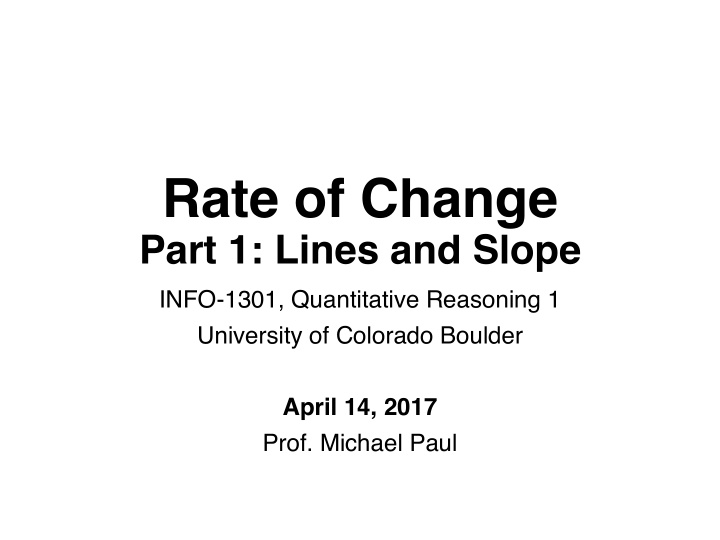



Rate of Change Part 1: Lines and Slope INFO-1301, Quantitative Reasoning 1 University of Colorado Boulder April 14, 2017 Prof. Michael Paul
Changes in data How does one variable change in relation to another? • Dollars saved and dollars in debt • Height of tree and altitude where it lives • Level of air pollution and respiratory illness cases • Value of car and number of miles driven
Reminder: Associations We previously learned that correlation is one way to measure the relationship between two variables Correlation=1.0 Correlation=-1.0 Positive correlation: if the value of one variable increases, the value of the other tends to increase Negative correlation: if the value of one variable increases, the value of the other tends to decrease
Reminder: Associations We previously learned that correlation is one way to measure the relationship between two variables Most data points are not perfectly straight lines, but you can imagine drawing a line through them.
Rate of change The rate of change of two variables describes how quickly and in what direction one variable is changing with respect to the other • Can be calculated for a line (slope) • Can be calculated between any two data points • Can be calculated at one data point (next week)
Rate of change The rate of change between two points (x 1 , y 1 ) and (x 2 , y 2 ) is defined as: y 2 – y 1 x 2 – x 1 “rise over run”
Lines Lines have a constant rate of change. Pick any two points on a line and you will get the same slope. (240 – 160) / (6 – 4) = 40 (160 – 80) / (4 – 2) = 40 (240 – 80) / (6 – 2) = 40
Lines The equation for a line is: y = ½ x + 1 y-intercept y = mx + b slope
Lines Data that form a straight line are called linear Real data sets are rarely exactly linear But often they are approximately linear This means we can roughly describe the data using the line equation, which let’s us reason about it easily
Lines Sometimes lines do not work as an approximation
Lines Linear approximations can work for segments of data
Lines Linear approximations can work for segments of data
Lines Linear approximations can work for segments of data What is the rate of change in temperature from Feb–Jul? (87.7 – 48.3) / 5 = 7.9 increase 7.9 degrees/month
Lines Linear approximations can work for segments of data What is the rate of change in temperature from Aug–Dec? (45.3 – 85.3) / 4 = -10 decrease 10 degrees/month
Practice y = mx + b What is m ? 1.5 What is b ? 3
Practice y = mx + b What is m ? -3 What is b ? 0
Practice Fisherman in the Finger Lakes Region have been recording the dead fish they encounter while fishing in the region. The Department of Environmental Conservation monitors the pollution index for the Finger Lakes Region. The model for the number of fish deaths y for a given pollution index x is y = 9.607x + 111.958. Describe the meaning of the slope. If the pollution index increases by 1, there will be 9-10 more fish deaths during the year.
Practice The average lifespan of Americans has increased over time. The average lifespan of an American in a given year is approximately y = 0.2x + 73, where x is the number of years since 1960. What was the approximate lifespan in 1980? What will be the approximate lifespan in 2020? What will be the approximate lifespan in 2400? • Unknown in 2400. This model is likely a bad approximation for that large of an interval.
Recommend
More recommend